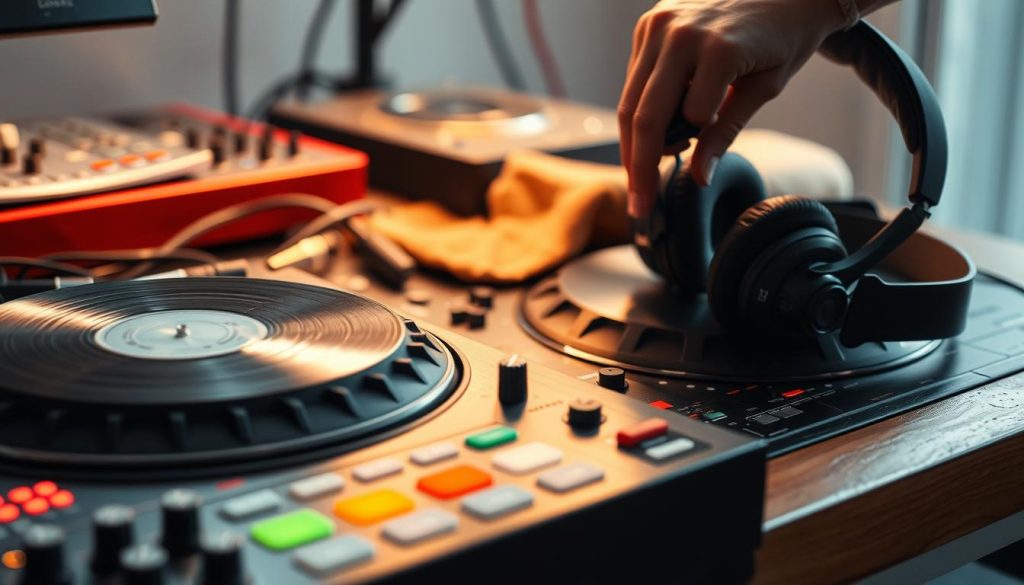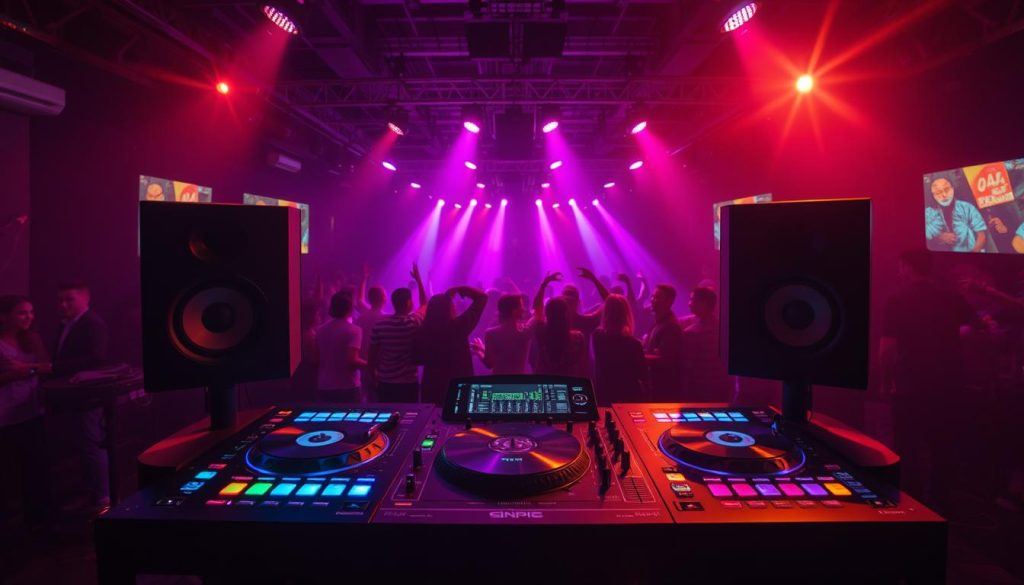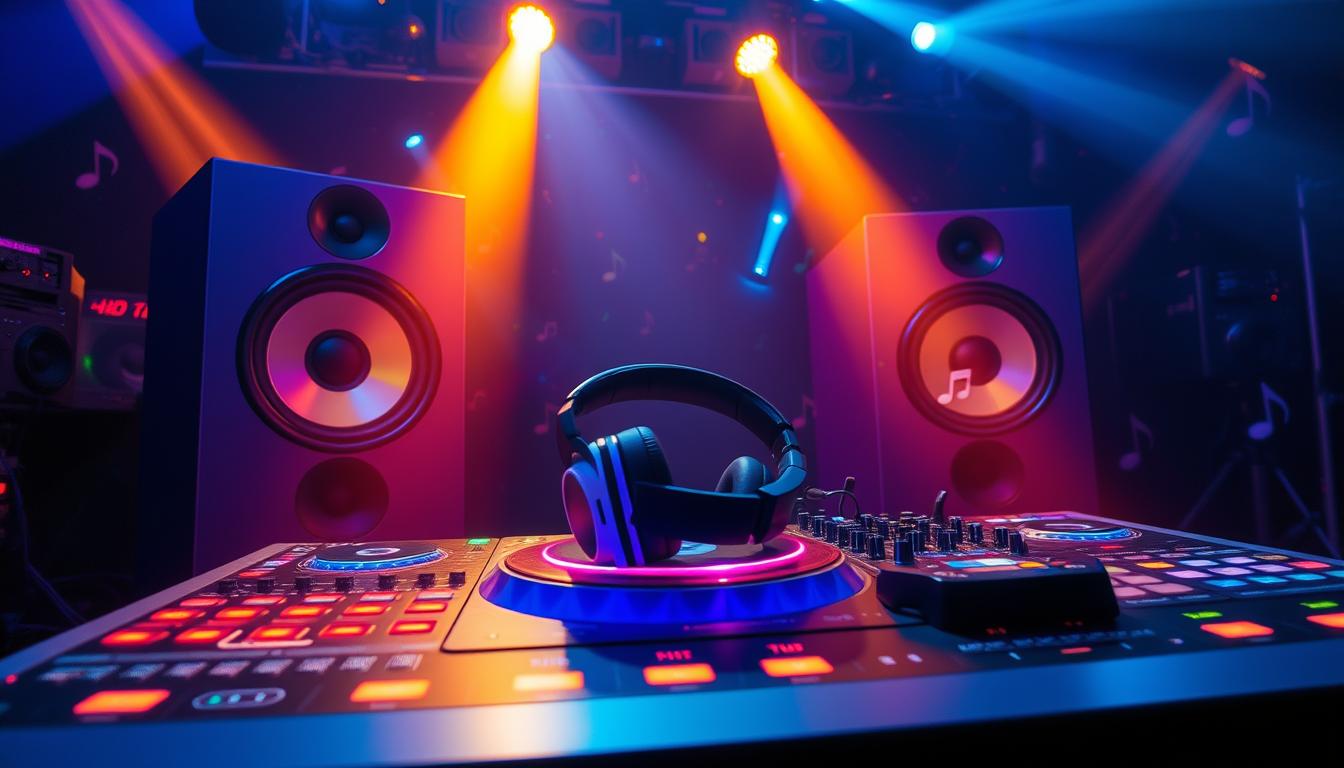As a passionate DJ, I know how crucial a great audio setup is. Sound is the heart of any DJ’s show. Without it, the music loses its beat, and the dance floor empties. I’m here to share my knowledge and help you make an audio experience that will wow your audience.
This guide will cover the key parts of a DJ sound system. We’ll look at mixers, turntables, speakers, and amplifiers. You’ll learn how each piece works and how to make it work best for you. This will help you make your DJ sets unforgettable.
Let’s start this journey together and make your audio setup amazing. By the end, you’ll know how to create a DJ sound system that takes your music to the next level. Let’s get started and find the path to stellar sound!
The Essence of a DJ’s Performance: Understanding the Components
In the world of DJing, the sound system is key. It brings the energy of a performance to life. At its heart is the mixer, called the “brain” of the setup. DJs use it to mix tracks, adjust volumes, and add effects.
The Mixer: The Brain of the Setup
The DJ mixer is where the magic happens. It lets DJs switch tracks smoothly and perfect the sound. With its controls and features, DJs can shape the music and wow their fans.
Turntables and Controllers: Music Manipulation Masters
Turntables have been a DJ’s go-to for years. They let DJs spin vinyl records for unique sounds. Now, DJ controllers are also popular. They make mixing digital music easy and precise.
Speakers: Transforming Signals into Sound
Speakers are crucial for a DJ’s setup. They turn electrical signals into the sound we hear. The quality and position of speakers greatly affect the music’s quality and how the audience experiences it.
These key parts – the DJ mixer, turntables, controllers, and speakers – are vital for a DJ’s show. They help create an immersive and memorable sound for the audience.
Vintage Audio Gear That Stands the Test of Time
I love vintage audio gear because it has a special charm. These pieces have a unique sound that modern gear can’t match. From warm amplifiers to powerful speakers, they offer an unmatched listening experience.
Amplifiers: The Heavyweight Champions
Vintage amplifiers are known as the “heavyweight champions” of audio. They’re built to last with great engineering and quality parts. You can find everything from tube amplifiers to solid-state ones, all delivering sound quality that beats modern gear.
Speakers: Durable Boxes with Powerful Sound
Vintage speakers are a big deal in classic audio. They have solid wood cabinets and top-notch drivers. Their sound is deep and clear, taking listeners back to the golden age of audio. Pairing a vintage amplifier with these speakers is a treat for the ears.
| Vintage Audio Gear | Key Features | Benefits |
|---|---|---|
| Vintage Amplifiers |
|
|
| Vintage Speakers |
|
|
Exploring vintage audio gear has shown me the amazing craftsmanship and detail in these classics. Whether you’re an expert or new to vintage audio, these components offer a rewarding experience. They make listening to music a memorable event.
Preparing Your audio equipment for Optimal Performance

Before you start setting up your DJ sound system, make sure your equipment is ready. This step is key for a great performance. It ensures your gear is in top shape and ready to sound amazing.
Here are the important steps to get your DJ equipment ready:
- Inventory Check: List all your DJ gear, like mixers, turntables, controllers, speakers, and accessories. Make sure you have everything and that it works well.
- Equipment Inspection: Look over each piece for damage, wear, or problems. Check cables for damage and connections for tightness. Fix or replace anything that’s not right.
- Cleaning and Maintenance: Clean your DJ equipment to keep it running well. Use the right cleaners to get rid of dust and dirt. Make sure nothing blocks the equipment’s parts.
- Workspace Organization: Keep your workspace tidy. Have a special area for your gear. This helps avoid accidents and damage.
- Safe Handling: Be gentle with your equipment. Don’t push too hard on cables or controls. Protect your gear and work safely.
Spending time on these steps helps set up your DJ sound system for success. A well-kept workspace boosts your gear’s performance. It also makes setting up easier and smoother.
Step-by-Step Guide: Setting Up Your DJ Sound System

Creating a great DJ experience starts with a good sound system. It doesn’t matter if you’re new or experienced. A clear setup process is key to a great show. Let’s look at the main steps to get your DJ sound system ready for the spotlight.
Speaker Placement: The Foundation of Great Sound
Putting your speakers in the right spot is key for great sound. Think about the size and layout of where you’ll be playing. Place your speakers to spread sound evenly across the area. Try different angles and distances to get the best sound.
Connecting the Pieces: A Harmonious Setup
With your speakers set, connect your audio equipment. Link your mixer to your turntables or controllers first. Then, connect the mixer to your speakers or amplifier with the right cables. Check all connections to avoid problems, and turn on your gear in the right order.
By doing these steps, you’ll have your DJ sound system ready for a great show. Remember, paying attention to details and planning well is important. It helps get the sound just right and makes your show memorable for everyone.
The Impact of Room Acoustics on Sound Quality
As a DJ, knowing about room acoustics is key for a great sound. The room’s size, shape, and materials affect sound waves. This changes the sound quality. By learning about sound waves and using acoustic treatments, DJs can make their music sound perfect.
Understanding How Sound Travels
Sound waves act in complex ways, affected by their surroundings. Hard surfaces like walls and floors bounce sound waves back, causing echoes. Soft materials absorb sound, making the sound clearer.
Knowing how sound waves work helps DJs improve their space’s acoustics. By fixing problem areas with acoustic treatments, DJs can make their music sound clear and balanced.
Acoustic Treatments: Enhancing Sonic Perfection
Acoustic treatments help control sound waves in a room. They include panels, diffusers, and bass traps. These are placed to fix specific sound issues.
- Sound-absorbing panels: These materials, like foam, cut down on sound reflections. This reduces echoes.
- Diffusers: These devices spread sound waves out. This makes the sound even in the room and less affected by reflections.
- Bass traps: These absorb low-frequency sound waves. They stop the music from sounding too boomy.
Using these treatments, DJs can improve their music’s sound quality. Their music will be clear, deep, and balanced.
Getting good at room acoustics is key for a great sound. By understanding sound waves and using acoustic treatments, DJs can make their shows amazing. Their music will sound perfect to the audience.
Fine-Tuning audio equipment: The Sound Check Process
As a pro DJ, I know how key it is to fine-tune my gear for the perfect sound. After setting up my DJ setup and checking the room’s sound, it’s time for a sound check. I play a track I know well, listen closely, and tweak the mixer’s volume and EQ settings to get a clean sound.
This process helps me make sure my show sounds great for everyone listening. Whether it’s adding more bass or making vocals clearer, adjusting my gear is vital. It makes my performance better and more enjoyable for the audience.
During the sound check, I pay attention to important things like how well my gear is tuned and how the sound is balanced. By focusing on these areas and making changes as needed, I can make sure my music sounds amazing. This way, I can keep my audience hooked and leave a strong impression.

